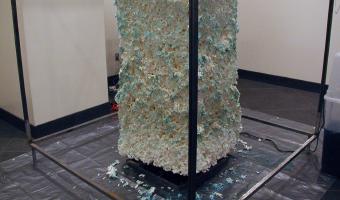
Although there are older data sculptures (see our entry 1995 – Loren Madsen’s Early Data Sculptures), this installation from artist Ethan Ham may have been the first artifact to be called a data sculpture.
In 2005, Andrew Vande Moere, a Design Professor and author of the now discontinued data visualization blog infosthetics, described the installation as:
an art installation that automatically creates physical data sculptures, using spam & e-mail as data to trigger the sculpting […]
Although there are older data sculptures (see our entry 1995 – Loren Madsen’s Early Data Sculptures), this installation from artist Ethan Ham may have been the first artifact to be called a data sculpture.
In 2005, Andrew Vande Moere, a Design Professor and author of the now discontinued data visualization blog infosthetics, described the installation as:
an art installation that automatically creates physical data sculptures, using spam & e-mail as data to trigger the sculpting process. the installation contains robot—like mechanisms that function like a flat-bed plotter, squirting water to dissolve sections of a large block of biodegradable (starch-based) styrofoam. each of the bots is associated with an email address, which triggers to either move or squirt water, depending on an algorithm that uses the email’s content as input data.
I emailed Ethan Ham to ask for more explanations and he responded:
It’s been a while, but I believe what the sculpture would do is take the email’s raw data, convert it to a numeric representation, and then use that number to drive an action (rotate sculpture, raise/lower sprayer, spray).
So according to Robert Kosara (archived version), this installation is a data-driven artifact but not a visualization in the pragmatic sense.
Sources:
Ethan Ham (2006) Email Erosion. (archived version) Pierre Dragicevic and Yvonne Jansen (2017) Data Physicalization Wiki, Terminology First quote by Andrew Vande Moere (2005) email erosion Second quote and high-res photos from Ethan Ham, sent in a personal e-mail in August 2024.









